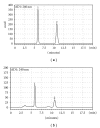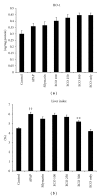Hepatoprotective and Antioxidative Activities of Cornus officinalis against Acetaminophen-Induced Hepatotoxicity in Mice
- PMID: 21869901
- PMCID: PMC3159024
- DOI: 10.1155/2012/804924
Hepatoprotective and Antioxidative Activities of Cornus officinalis against Acetaminophen-Induced Hepatotoxicity in Mice
Abstract
The fruit of Cornus officinalis Sieb. et Zucc. is commonly prescribed in Asian countries as a tonic formula. In this study, the hepatoprotective effect of ethanolic extracts of the fruit of C. officinalis (ECO) was investigated in a mouse model of acetaminophen- (APAP-) induced liver injury. Pretreatment of mice with ECO (100, 250, and 500 mg/kg for 7 days) significantly prevented the APAP (200 mg/kg) induced hepatic damage as indicated by the serum marker enzymes (AST, ALT, and LDH). Parallel to these changes, ECO treatment also prevented APAP-induced oxidative stress in the mice liver by inhibiting lipid peroxidation (MDA) and restoring the levels of antioxidant enzymes (SOD, CAT, and HO-1) and glutathione. Liver injury and collagen accumulation were assessed using histological studies by hematoxylin and eosin staining. Our results indicate that ECO can prevent hepatic injuries associated with APAP-induced hepatotoxicity by preventing or alleviating oxidative stress.
Figures






Similar articles
-
Shikonin attenuates acetaminophen-induced acute liver injury via inhibition of oxidative stress and inflammation.Biomed Pharmacother. 2019 Apr;112:108704. doi: 10.1016/j.biopha.2019.108704. Epub 2019 Feb 25. Biomed Pharmacother. 2019. PMID: 30818140
-
Hepatoprotective and antioxidant effects of Cuscuta chinensis against acetaminophen-induced hepatotoxicity in rats.J Ethnopharmacol. 2007 Apr 20;111(1):123-8. doi: 10.1016/j.jep.2006.11.003. Epub 2006 Nov 11. J Ethnopharmacol. 2007. PMID: 17145147
-
Detoxifying effect of pyridoxine on acetaminophen-induced hepatotoxicity via suppressing oxidative stress injury.Food Chem Toxicol. 2018 Apr;114:11-22. doi: 10.1016/j.fct.2018.02.017. Epub 2018 Feb 10. Food Chem Toxicol. 2018. PMID: 29438775
-
Seabuckthorn berry polysaccharide extracts protect against acetaminophen induced hepatotoxicity in mice via activating the Nrf-2/HO-1-SOD-2 signaling pathway.Phytomedicine. 2018 Jan 1;38:90-97. doi: 10.1016/j.phymed.2017.11.007. Epub 2017 Nov 14. Phytomedicine. 2018. PMID: 29425659
-
Protective Effect of Fresh/Dry Dandelion Extracts on APAP-Overdose-Induced Acute Liver Injury.Chin J Integr Med. 2022 Aug;28(8):683-692. doi: 10.1007/s11655-021-3295-8. Epub 2021 Nov 24. Chin J Integr Med. 2022. PMID: 34816363
Cited by
-
The herbal formula KH-204 is protective against erectile dysfunction by minimizing oxidative stress and improving lipid profiles in a rat model of erectile dysfunction induced by hypercholesterolaemia.BMC Complement Altern Med. 2017 Feb 24;17(1):129. doi: 10.1186/s12906-017-1588-4. BMC Complement Altern Med. 2017. PMID: 28235412 Free PMC article.
-
Acetaminophen induces JNK/p38 signaling and activates the caspase-9-3-dependent cell death pathway in human mesenchymal stem cells.Int J Mol Med. 2015 Aug;36(2):485-92. doi: 10.3892/ijmm.2015.2254. Epub 2015 Jun 19. Int J Mol Med. 2015. PMID: 26096646 Free PMC article.
-
Hepatoprotective effects of Gamisoyo-san against acetaminophen-induced liver injuries.Integr Med Res. 2021 Mar;10(1):100466. doi: 10.1016/j.imr.2020.100466. Epub 2020 Jul 1. Integr Med Res. 2021. PMID: 32904181 Free PMC article.
-
Neocornuside A-D, Four Novel Iridoid Glycosides from Fruits of Cornus officinalis and Their Antidiabetic Activity.Molecules. 2022 Jul 24;27(15):4732. doi: 10.3390/molecules27154732. Molecules. 2022. PMID: 35897906 Free PMC article.
-
[Effects and mechanism of morroniside on osteogenic differentiation and proliferation of mouse MC3T3-E1 cells].Zhongguo Xiu Fu Chong Jian Wai Ke Za Zhi. 2022 Jul 15;36(7):889-895. doi: 10.7507/1002-1892.202202088. Zhongguo Xiu Fu Chong Jian Wai Ke Za Zhi. 2022. PMID: 35848187 Free PMC article. Chinese.
References
-
- Jayaprakasam B, Vareed SK, Olson LK, Nair MG. Insulin secretion by bioactive anthocyanins and anthocyanidins present in fruits. Journal of Agricultural and Food Chemistry. 2005;53(1):28–31. - PubMed
-
- Hatano T, Ogawa N, Kira R, Yasuhara T, Okuda T. Tannins of cornaceous plants. I. Cornusiins A, B and C, dimeric monomeric and trimeric hydrolyzable tannins from Cornus officinalis, and orientation of valoneoyl group in related tannins. Chemical & Pharmaceutical Bulletin. 1989;37:2083–2090. - PubMed
-
- Wang SF, Chen XG, Hu ZD, Ju Y. Analysis of three effective components in fructus corni and its preparations by micellar electrokinetic capillary chromatography. Biomedical Chromatography. 2003;17:306–311. - PubMed
-
- Xu H, Shen J, Liu H, Shi Y, Li H, Wei M. Morroniside and loganin extracted from Cornus officinalis have protective effects on rat mesangial cell proliferation exposed to advanced glycation end products by preventing oxidative stress. Canadian Journal of Physiology and Pharmacology. 2006;84(12):1267–1273. - PubMed
-
- Yokozawa T, Park CH, Noh JS, Tanaka T, Cho EJ. Novel action of 7-O-galloyl-D-sedoheptulose isolated from corni fructus as a hypertriglyceridaemic agent. Journal of Pharmacy and Pharmacology. 2009;61(5):653–661. - PubMed
LinkOut - more resources
Full Text Sources
Miscellaneous

